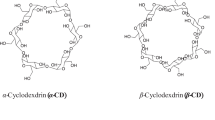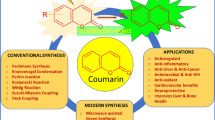Abstract
The inclusion complexations of rhodamine derivatives with native and 2,6-di-O-methylated β-cyclodextrins (β-CD and DM-β-CD) were studied spectrophotometrically. Rhodamine derivatives were shown to form 1:1 inclusion complexes with β-CDs by the continuous variation method. The structures of the inclusion complexes were characterized by 1H-1H rotating frame nuclear Overhauser effect spectroscopy (ROESY) NMR measurements. It was found that native β-CD encapsulates the xanthenyl ring of rhodamines into the cyclodextrin cavity, while DM-β-CD forms two group-in complexes (phenyl-in and xanthenyl-in (bidirectional (bimodal) inclusion complexes)) with rhodamines bearing moderately bulky functional groups. Furthermore, we demonstrated the unique thermodynamics for the group-inclusion complex formation by DM-β-CD. The quantum yields for the inclusion complexes of rhodamines were determined using a quantum measurement apparatus equipped with a half-moon unit. The results indicated that the cyclodextrin inclusion of rhodamines with the bulky amino substituents on the xanthenyl ring largely decreases the quantum yield values. Based on these results, the substituent effects on the fluorescence process for the cyclodextrin inclusion complexes of rhodamines were discussed. This study provides useful insights for the functional group recognition of native and modified β-CDs.





Similar content being viewed by others
References
Fabiola, Z., Antonio, C., Arturo, E., Alberto, T., Pedro, M.: Triple channel sensing of Pb(II) Ions by a simple multiresponsive ferrocene receptor having a 1-deazapurine backbone. Org. Lett. 10, 41–44 (2008)
Fabbizzi, L., Poggi, A.: Sensors and switches from supramolecular chemistry. Chem. Soc. Rev. 25, 197–202 (1995)
Guiyuan, J., Sheng, W., Wenfang, Y., Lei, J., Yanlin, S., He, T., Daoben, Z.: Highly fluorescent contrast for rewritable optical storage based on photochromic bisthienylethene-bridged naphthalimide dimer. Chem. Mater. 18, 235–237 (2006)
Pu, S., Ding, H., Liu, G., Zheng, C., Xu, H.: Multiaddressing fluorescence switch based on a new photochromic diarylethene with a triazole-linked rhodamine B unit. J. Phys. Chem. 118, 7010–7017 (2014)
Yang, Y.K., Yook, K.J., Tae, J.: A rhodamine-based fluorescent and colorimetric chemodosimeter for the rapid detection of Hg2+ ions in aqueous media. J. Am. Chem. Soc. 127, 16760–16761 (2005)
Zhang, X.-F., Zhang, J., Lu, X.: The fluorescence properties of three rhodamines dye analogues: acridine red, pyronin Y and pyronin B. J. Fluoresc. 25, 1151–1158 (2015)
Chang, T.-L., Cheung, H.C.: A model for molecules with twisted intramolecular charge transfer characteristics: solvent polarity effect on the nonradiative rates of dyes in a series of water-ethanol mixture solvents. Chem. Phys. Lett. 173, 343–348 (1990)
Selwyn, J.E., Steinfeld, J.I.: Aggregation equilibria of xanthene dyes. J. Phys. Chem. 76, 762–774 (1972)
Halterman, R.L., Moore, J.L., Yakshe, K.A., Halterman, J.A.I., Woodson, K.A.: Inclusion complexes of cationic xanthene dyes in cucurbit[7]uril. J. Incl. Phenom. Macrocycl. Chem. 66, 231–241 (2010)
Mohanty, J., Nau, W.M.: Ultrastable rhodamine with cucurbituril. Angew. Chem. Int. Ed. 44, 3750–3754 (2005)
Buschmann, H.-J., Schollmeyer, E.: Stabilization of dyes against hydrolytic decomposition by the formation of inclusion compounds. J. Incl. Phenom. Macrocycl. Chem. 7, 133–141 (1992)
Mohanty, J., Pal, H., Ray, A.K., Kumar, S., Nau, W.M.: Supramolecular dye laser with cucurbit[7]uril in water. Chem. Phys. Chem. 8, 54–56 (2007)
Saenger, W.: Cyclodextrin inclusion compounds in research and industry. Angew Chem. Int. Ed. Engl. 19, 344–362 (1980)
Wagner, B.D., Fitzpatrick, S.J.: A comparison of the host-guest inclusion complexes of 1,8-ANS and 2,6-ANS in parent and modified cyclodextrins. J. Incl. Phenom. Macrocycl. Chem. 38, 467–478 (2000)
Velapoldi, R.A., Tonnesen, H.H.: Corrected emission spectra and quantum yields for a series of fluorescent compounds in the visible spectra region. J. Fluoresc. 14, 465–472 (2004)
Job, P.: Formation and stability of inorganic complexes in solution. Ann. Chim. 9, 113–203 (1928)
Scott, R.L.: Some comments on the Benesi-Hildebrand equation. Rel. Trav. Chim. Pays-Bas 75, 787–789 (1956)
Kotake, Y., Janzen, E.G.: Bimodal inclusion of nitroxide radicals by β-cyclodextrin in water as detected by electron spin resonance. J. Am. Chem. Soc. 110, 3699–3701 (1988)
Casy, A.F., Cooper, A.D., Jefferies, T.M., Caskell, R.M., Greatbanks, D., Pickford, R.: HPLC and 1H-NMR study of chiral recognition in some thromboxane antagonists induced by β-cyclodextrin. J. Pharm. Biomed. Anal. 9, 787–792 (1991)
Cai, W., Yao, X., Shao, X., Pan, Z.: Bimodal complexation of steroids with cyclodextrins by a flexible docking algorithm. J. Incl. Phenom. Macrocycl. Chem. 51, 41–51 (2005)
Leffler, J.E.: The interpretation of enthalpy and entropy data. J. Org. Chem. 31, 533–537 (1966)
Drexhang, K.H.: Schäfer, F.P (ed) Dye Laser. Springer, Berlin (1977)
Arbeloa, T.L., Arbeloa, F.L., Bartolome, P.H., Arbeloa, I.L.: On the mechanism of radiationless deactivation of rhodamines. Chem. Phys. 160, 123–130 (1992)
Vogel, M., Rettig, W., Sens, R., Drexhage, K.H.: Structural relaxation of rhodamine dyes with different N-substitution patterns: a study of fluorescence decay times and quantum yields. Chem. Phys. Lett. 147, 452–459 (1988)
Author information
Authors and Affiliations
Corresponding author
Additional information
Publisher's Note
Springer Nature remains neutral with regard to jurisdictional claims in published maps and institutional affiliations.
Electronic supplementary material
Below is the link to the electronic supplementary material.
Rights and permissions
About this article
Cite this article
Sueishi, Y., Matsumoto, Y., Kimata, Y. et al. Characterization of group-inclusion complexations of rhodamine derivatives with native and 2,6-di-O-methylated β-cyclodextrins. J Incl Phenom Macrocycl Chem 96, 365–372 (2020). https://doi.org/10.1007/s10847-020-00979-y
Received:
Accepted:
Published:
Issue Date:
DOI: https://doi.org/10.1007/s10847-020-00979-y




